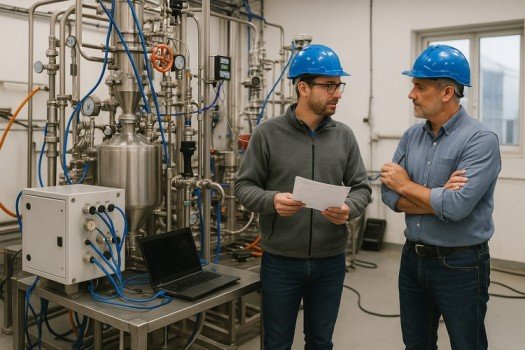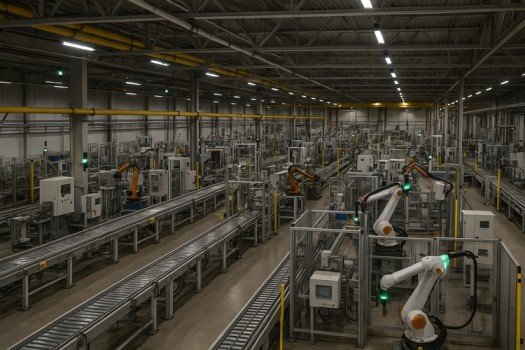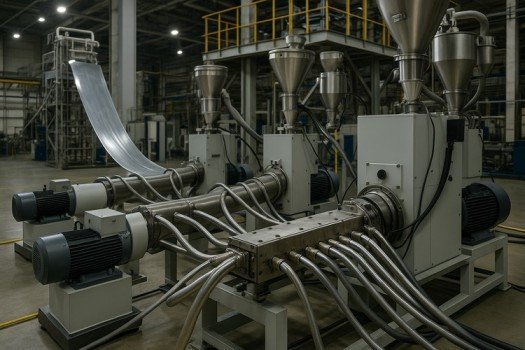You know how every manufacturing plant has that one machine that breaks down at the worst possible moment? Smart manufacturing fixes these problems before they happen—and the waste reduction is just the beginning.
TL;DR Summary
- Smart manufacturing spots waste before it hits your bottom line through real-time monitoring
- Six key technologies tackle everything from energy waste to quality defects
- Predictive systems prevent problems instead of reacting to them
- Implementation takes planning, but efficiency gains show up fast
- Connected factories save money while hitting sustainability targets
Understanding Production Waste in Modern Manufacturing
Manufacturing waste isn’t just an environmental problem—it’s bleeding money in ways most companies don’t track. Recent global waste management trends show that industrial waste dwarfs consumer waste, yet most manufacturers still operate like waste is just the cost of doing business.
Here’s what most people miss: waste happens in layers. Material waste is obvious—scrap bins don’t lie. Energy waste hides in equipment running when it shouldn’t, systems operating inefficiently, and poor scheduling. Time waste shows up as unplanned downtime and manual processes that could run automatically.
Traditional manufacturing waits for problems to announce themselves through breakdowns and quality failures. Smart manufacturing flips this completely. Instead of reacting to waste after it costs you money, factory automation and digital systems catch inefficiencies while you can still prevent them.
Understanding how to use smart manufacturing to reduce waste starts with recognizing these patterns before they cost you money. That’s all good, but it isn’t where the heart of the waste problem lies. The hyper-growth of the global economy has led to hyper-waste, and AI waste reduction research shows that industrial waste generation is almost 18 times greater than regular trash.
6 Smart Manufacturing Technologies That Eliminate Production Waste
The real breakthrough isn’t any single technology—it’s how these systems work together to create visibility where you had none and control where you were just reacting.
Predictive Maintenance with AI in Manufacturing
Predictive maintenance changed everything when I watched a client avoid a $200,000 production shutdown because sensors caught bearing wear three weeks early. IoT sensors monitor vibration, temperature, and pressure—all the signals equipment gives before it fails. Machine learning algorithms learn what normal looks like, then flag anything abnormal.
The technology creates digital fingerprints for each piece of equipment. As sensors detect deviations, AI calculates failure probability weeks ahead. Maintenance teams get alerts with enough lead time to schedule repairs during planned downtime and avoid cascading failures.
Start with your most critical equipment—the stuff that shuts down entire lines when it breaks. The system gets smarter over time, correlating sensor readings with actual outcomes. Companies report cutting unplanned downtime dramatically while extending equipment life.
Real-Time Quality Systems Using Machine Learning for Quality Control
Traditional quality control catches defects after you’ve wasted materials, labor, and time. Real-time monitoring prevents defective products from moving down the line by identifying quality issues as they develop.
Computer vision systems inspect products at multiple stages, comparing what they see against quality standards. Machine learning processes this data to identify patterns that predict quality problems before defects become visible. Advanced systems automatically adjust production settings when they detect conditions likely to produce defects.
This eliminates waste by preventing defective products from consuming additional resources. Labor costs drop as automated systems replace manual inspection for routine checks. Customer satisfaction improves because fewer defective products are in production.

Smart Energy and Resource Management with IoT for Production
IoT creates comprehensive visibility into how equipment actually performs versus how it should perform. Connected sensors monitor everything from motor temperatures to cycle times, generating continuous data streams that reveal optimization opportunities.
Pattern recognition algorithms spot inefficiencies human operators might miss—gradual performance degradation or equipment working harder than necessary. Smart systems make real-time adjustments to maintain optimal performance as conditions change.
Energy management represents the biggest opportunity here. IoT systems track consumption patterns and identify equipment operating inefficiently. Automated controls reduce usage during low-demand periods and optimize production schedules to avoid peak energy costs.
AI-Powered Planning and Automated Process Optimization
Overproduction waste happens when you make more than customers actually need. AI-powered demand forecasting reduces this by improving production planning accuracy and optimizing inventory levels.
Machine learning analyzes historical sales data, market trends, and external factors that influence demand. Advanced models incorporate real-time data from sales systems and supply chain partners to adjust forecasts dynamically. The forecasting system connects to production planning tools that automatically adjust manufacturing schedules.
Automated process control systems maintain precise operating conditions that maximize efficiency and minimize waste. These systems use feedback loops that continuously monitor parameters and make real-time adjustments. Advanced controllers incorporate machine learning that improves performance over time.
Robotic Process Automation for Manufacturing
Robotics eliminates waste from human error, variability, and inefficiency while enabling precise, consistent operations. Modern collaborative robots work alongside human operators to enhance productivity rather than replace workers.
Robotic systems excel at repetitive tasks requiring precision and consistency. They operate continuously without fatigue, maintaining quality standards that reduce waste from defective products. Integration with smart manufacturing systems enables robots to respond to real-time production data and coordinate with other automated systems. This robotics-in-production approach transforms how manufacturing facilities handle repetitive tasks while implementing best practices for a lean and smart factory.

Integrated Analytics and Digital Twins
Digital twins create virtual replicas of production systems that enable simulation and optimization without disrupting actual operations. These models combine real-time IoT data with physics-based simulations to predict system behavior under different conditions.
Manufacturing teams can test process changes and production schedules in the digital environment before implementing them physically. This eliminates waste from trial-and-error approaches and reduces the risk of implementing changes that decrease efficiency.
Data analytics platforms process operational data to identify patterns that reveal underlying sources of waste and inefficiency. Machine learning analyzes relationships between process parameters, quality outcomes, and operational efficiency, revealing improvement opportunities that weren’t previously apparent.
When deciding which technology to tackle first, this breakdown helps you choose based on your biggest pain points:
| Technology | Primary Waste Target | Implementation Complexity | Time to Value |
| Predictive Maintenance | Unplanned Downtime | Medium | 3-6 months |
| Real-Time Quality Systems | Defect-Related Waste | Medium | 2-4 months |
| Smart Energy Management | Energy & Resource Waste | High | 6-12 months |
| AI-Powered Planning | Overproduction Waste | Low | 1-3 months |
Industry 4.0 Implementation: Building Connected Smart Factories
Manufacturing executives are notably confident in the potential of smart factory solutions as primary drivers of competitiveness over the next five years, according to manufacturing industry analysis from industry leaders.
Most successful implementations start with clear objectives, pilot programs that demonstrate value, and systematic expansion based on proven results. The companies that struggle try to transform everything at once instead of building capabilities gradually.
Connected factories require robust IT infrastructure to handle massive data volumes from IoT sensors and analytics platforms. Production line strategy considerations become critical for managing real-time analysis. The integration process typically follows a phased approach, starting with foundational technologies like IoT sensors, then adding predictive capabilities and advanced optimization as digital maturity increases.
Measuring Production Waste Reduction Success
Effective measurement systems track both immediate improvements and long-term trends. Key performance indicators should align with business objectives while providing actionable insights for continuous improvement.
Operational efficiency metrics include Overall Equipment Effectiveness (OEE), which combines availability, performance, and quality measures. Learning how to improve OEE (Overall Equipment Effectiveness) with smart factory tools becomes critical for tracking progress. Energy efficiency ratios track resource consumption relative to production output, revealing further optimization opportunities. These metrics support waste minimization efforts and provide the foundation for implementing lean manufacturing principles.
Many companies find that carbon footprint tracking provides valuable insights for both operational and environmental improvements. Data visualization platforms present performance metrics in formats that enable quick understanding and decision-making.
Digital Transformation in Manufacturing: Future-Proofing Operations
Manufacturing digital transformation continues evolving as new technologies mature and integration capabilities expand. Organizations that build flexible, scalable smart manufacturing foundations position themselves to adopt emerging technologies as they become available.
Artificial intelligence capabilities will expand beyond current predictive applications to include autonomous decision-making and self-optimizing systems. Edge computing will bring more processing power closer to production equipment, enabling faster response times.
The integration of how stone paper is made and other sustainable manufacturing processes demonstrates how traditional industries are adapting smart manufacturing principles to reduce environmental impact while improving efficiency.
Smart Manufacturing Case Studies: Proven Waste Reduction Results
Implementation success stories demonstrate practical benefits across different industries. Automotive manufacturers have achieved significant waste reduction through predictive maintenance programs that minimize unplanned downtime. Food processing companies use real-time quality monitoring to reduce product waste and ensure safety compliance.
Electronics manufacturers leverage advanced production scheduling to optimize complex multi-stage processes. Chemical processing facilities implement digital twins to optimize reaction conditions and reduce raw material waste.
Pilot programs demonstrate value before full-scale deployment, allowing organizations to build expertise and refine approaches. Companies that invest in data quality, employee training, and change management achieve better results and faster adoption rates.
Partnership strategies often prove valuable for implementing complex smart manufacturing solutions. Organizations like Plentiful Choices combine engineering expertise, international sourcing capabilities, and digital transformation experience to provide comprehensive implementation support.
Conclusion
Smart manufacturing represents a fundamental shift from reactive to proactive operations that eliminates waste before it impacts production. The integration of IoT sensors, AI analytics, and automated systems creates visibility and control capabilities that traditional manufacturing approaches simply can’t match.
Success requires strategic implementation that addresses technology, people, and processes simultaneously. Organizations that start with clear objectives, demonstrate value through pilot programs, and build capabilities systematically achieve the best results.
FAQ
Smart manufacturing integrates IoT sensors, AI analytics, and automation to provide real-time visibility into production processes. This enables predictive maintenance, quality optimization, and resource efficiency that eliminates waste before it occurs.
Predictive maintenance and real-time quality monitoring typically show results within 3-6 months. These technologies address high-impact waste sources like unplanned downtime and defective products that directly affect profitability.
Common challenges include integrating legacy equipment with modern systems, ensuring data quality and security, and developing technical skills. Cultural change management is often underestimated but critical for success.








